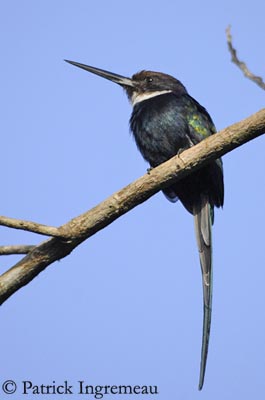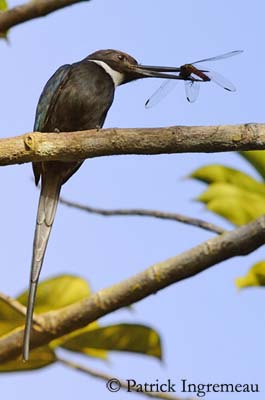
Paradise Jacamar
Galbula dea
Piciforme Order – Galbulidae Family
BIOMETRICS :
Length : 26-34 cm
Weight : 25-32 g
DESCRIPTION:
Paradise Jacamar is a bird of the forest canopy.
FLIGHT:
The Paradise Jacamar has swift flight. It performs brief sallies and chases preys in the air, before to return to the perch in canopy.
When it flies between two feeding areas, or when it is threatened, it performs bursts of rapid wing beats interspersed with glides, giving an undulating flight.
This species is also able to fly long distances.
REPRODUCTION:
The breeding season varies according to the rainfalls and the food resources.
The Paradise Jacamar excavates its nest in arboreal termitary high in trees in the canopy.
It performs some displays such as courtship feeding by the male, and vocalises.
These birds use the bill for digging the burrow. The debris is removed with the feet. Male and female excavate the nest together. The nest-chamber is at the end of the burrow and often unlined.
The female lays 2 to 4 white glossy eggs. Incubation is made by both male and female, and both parents share the nesting duties.
DIET:
The Paradise Jacamar forages from high perch in canopy. When the prey is detected, it makes a dive, or pursues it in swift flight for catching it, and returns to its perch. It feeds mainly on flying insects and butterflies, and it takes spiders from their webs while flying.
Its preferred preys are butterflies, moths, dragonflies, wasps, bees, flying ants, flies, beetles and cicadas.
PROTECTION / THREATS / STATUS:
The Paradise Jacamar is generally common, but it is difficult to see because it is often perched in the canopy.
It could be threatened by habitat loss in the future, but at this moment, this species is not globally threatened.
Fr: Jacamar à longue queue
All : Paradiesglanzvogel
Esp : Jacamará Colilargo
Ital: Jacamar del Paradiso
Nd: Paradijsglansvogel
Russe: Райская якамара
Photographs by Patrick Ingremeau
His website : TAMANDUA
Text by Nicole Bouglouan
Sources:
HANDBOOK OF THE BIRDS OF THE WORLD Vol. 7 by Josep del Hoyo-Andrew Elliott-Jordi Sargatal – Lynx Edicions – ISBN: 8487334377
A GUIDE TO THE BIRDS OF COLOMBIA by Steven L. Hilty and William L. Brown
Princeton University Press – ISBN 069108372X
PORTRAITS D’OISEAUX GUYANAIS - Groupe d'étude et de protection des oiseaux en Guyane (GEPOG) - Ibis rouge éditions - ISBN: 2844501842

The adult male has glossy black plumage on the upperparts, with bluish sheen. The upper wings are iridescent blue-black, and greener on the coverts.
The tail is narrow, with two long central rectrices of about 14 to 18 cm.
On the underparts, the chin is blackish. Throat, upper breast and neck sides are white, as a half collar. The rest of the underparts are blackish with dark blue sheen. The undertail feathers are pale grey.
The head is dark brown, mainly on the crown. Cheeks and ear-coverts show slight greenish-black sheen.
The long needle-like bill of about 5 to 6, 5 cm is black. The eyes are dark brown. Legs and feet are black.
Both sexes are similar.
No available information about juvenile.
The Paradise Jacamar has four subspecies, G.d. dea; G.d. brunneiceps; G.d. phainopepla; G.d. amazonum. They differ in size of wings, tail and bill, and in colours of plumage.
VOICE: SOUNDS BY XENO-CANTO
The Paradise Jacamar is usually quiet. Its song is a long descending series of “peep” becoming weaker and faster at the end. The call is a “pip” or “glewweh”.
HABITAT:
The Paradise Jacamar is common in humid forests, várzea, dry forests and gallery forest along watercourses, and savannahs. It may be seen often below 500 metres of elevation, but locally, according to the range, it may be found up to 1100 metres.
RANGE:
The Paradise Jacamar is sedentary in its range. It is found in Venezuela, Brazil, Colombia, Bolivia, Peru and the Guyanas.
BEHAVIOUR:
The Paradise Jacamar lives mainly in the canopy and descends sometimes at lower level at the edges of the forest or in clearings.
This bird is often solitary, but sometimes, two or three jacamars perch in the same tree. It also may be seen in pairs, often on exposed dead branch in the upper canopy, or along borders, with raised head and bill, waiting for preys.

The Paradise Jacamar feeds primarily on flying insects and butterflies. It performs sallies in agile chases, pursues its prey and returns to the perch with undulating flight. It also may join flocks of mixed species in the canopy.
It is a diurnal species, roosting in burrows. Jacamars are sedentary and defend their food resources all year round. Some disputes between males occur, for mates, territory or nest-site. They may be aggressive towards each other, but physical contacts are rare.